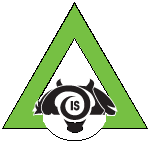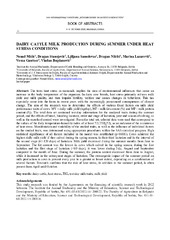Приказ основних података о документу
Dairy cattle milk production during summer under heat stress conditions
| dc.creator | Mićić, Nenad | |
| dc.creator | Stanojević, Dragan | |
| dc.creator | Samolovac, Ljiljana | |
| dc.creator | Nikšić, Dragan | |
| dc.creator | Lazarević, Marina | |
| dc.creator | Gantner, Vesna | |
| dc.creator | Bogdanović, Vladan | |
| dc.date.accessioned | 2023-10-27T10:13:57Z | |
| dc.date.available | 2023-10-27T10:13:57Z | |
| dc.date.issued | 2023-10 | |
| dc.identifier.isbn | 978-86-82431-81-7 | |
| dc.identifier.uri | http://r.istocar.bg.ac.rs/handle/123456789/926 | |
| dc.description.abstract | The term heat stress in mammals implies the sum of environmental influences that cause an increase in the body temperature of the organism. In dairy cow breeds, heat stress primarily reduces milk yield and milk quality, and then impairs fertility, welfare and causes changes in behaviour. This has especially come into the focus in recent years with the increasingly pronounced consequences of climate change. The aim of the research was to determine the effects of various fixed factors on milk yield performance traits of cows: MY – daily milk yield (kg/day), MF - milk fat content (%) and MP - milk protein content (%). The total data set contained test-day information for the analyzed traits during the summer period, and the effects of breed, breeding location, order and stage of lactation, year and season of calving, as well as the month of control were investigated. From the total set, selected data were used that correspond to the values of the daily temperature-humidity index of at least 72 (THI≥72), as an indicator of the occurrence of heat stress. Manifestation and variability of the studied traits, as well as the influence of individual factors on the studied traits, was determined using appropriate procedures within the SAS statistical program. High statistical significance of all factors included in the model was established (p<0.001). Cows achieved the highest daily milk yield if they calved during the spring season, in their third lactation and in the interval of the second stage (61-120 days) of lactation. Milk yield decreased during the summer months from June to September. The fat content was the lowest in cows which calved in the spring season, during the first lactation and the first stage of lactation (<60 days), it was lower during July, August and September compared to the month of June. During the summer, the protein content decreased from June to August, while it increased in the subsequent stages of lactation. The stressogenic impact of the summer period on milk production in cows is present every year to a greater or lesser extent, depending on a combination of several factors. Research confirms that the risk of heat stress, in addition to the summer period, is often present from April until October. | sr |
| dc.language.iso | en | sr |
| dc.publisher | Institut za stočarstvo, Beograd-Zemun | sr |
| dc.relation | info:eu-repo/grantAgreement/MESTD/inst-2020/200022/RS// | sr |
| dc.relation | info:eu-repo/grantAgreement/MESTD/inst-2020/200116/RS// | sr |
| dc.rights | openAccess | sr |
| dc.rights.uri | https://creativecommons.org/licenses/by/4.0/ | |
| dc.source | 14th International symposium „Modern trends in livestock production“, Book of abstracts | sr |
| dc.subject | dairy cattle, heat stress, THI, test-day milk traits, milk yield | sr |
| dc.title | Dairy cattle milk production during summer under heat stress conditions | sr |
| dc.type | conferenceObject | sr |
| dc.rights.license | BY | sr |
| dc.citation.spage | 14 | |
| dc.citation.epage | 14 | |
| dc.identifier.rcub | https://hdl.handle.net/21.15107/rcub_ristocar_926 | |
| dc.identifier.fulltext | http://r.istocar.bg.ac.rs/bitstream/id/4397/bitstream_4397.pdf | |
| dc.type.version | publishedVersion | sr |


